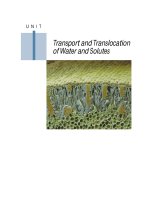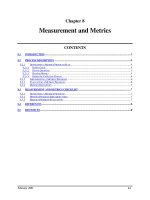Lecture Discovering nutrition - Chapter 8: Water and minerals
Bạn đang xem bản rút gọn của tài liệu. Xem và tải ngay bản đầy đủ của tài liệu tại đây (2.88 MB, 62 trang )
Chapter 8
Water &
Minerals:
The Ocean
Within
Water: Crucial to Life
•
Water is the most
essential nutrient
– 45–75% body weight
– Body water
•
2/3 Intracellular
•
1/3 Extracellular
Water: Crucial to Life
•
Electrolytes and
water
– When minerals or
salts dissolve in
water form ions:
•
Cation
•
Anions
– Osmosis
Intake Recommendations
•
How much water is
enough?
– Men = 3.7 liters/day AI
– Women = 2.7 liters/day
AI
– Pregnancy = 3.0
liters/day AI
– Lactation = 3.8
liters/day
– Increased needs for
activity and sweating
Intake Recommendations
•
Sources
– 75-80% from Beverages
– 20-25% from Foods
– Small amount from metabolic reactions
(250-350mL/day)
1.
2.
3.
4.
Water Excretion: Where Does the
Water
Go?
Insensible water losses: the
continuous loss of body water by
evaporation from the lungs and
diffusion through skin.
– ¼- ½ of daily fluid loss
Urine (~1-2 liters per day)
Illness
External factors that contribute to
water losses:
– Low humidity
– High altitude
Intake Recommendations
•
Water Balance
– Bodies carefully maintain water
balance
1. Hormonal effects
•
Antidiuretic hormone (ADH)
•
Aldosterone
2. Thirst
3. Alcohol, caffeine, and common
medications affect fluid balance
Water Balance – How do kidneys
know how to conserve water?
1.
2.
Spinal cells in brain sense rising sodium
levels in the body signals pituitary gland
to release ADH signals kidneys to
conserve water water reabsorption dilutes
sodium levels
Sensors in the kidneys detect a drop in
blood pressure adrenal glands release
aldosterone kidneys retain sodium
water follows sodium water reabsorption
Water Balance
•
Alcohol, caffeine,
and common
medications are
usually diuretics
– Alcohol and
caffeine are able
to inhibit the
release of ADH
(by the pituitary
gland)
– Too much
Intake Recommendations
•
Dehydration
– Early signs: Fatigue,
headache, and dark urine
with strong odor
– Water loss of 20% can
cause coma and death
– Seniors and infants
especially vulnerable
– Treatment: water
consumption (with
electrolytes) or IV
(moderate to severe cases)
Water Intoxication
•
Water intoxication:
– Can occur in people who drink too much
water
– Over-hydration can also occur in people
with untreated glandular disorders that
cause excessive water retention
– Deionized water (without
minerals/electrolytes)
– Causes low blood sodium headaches
seizures coma death
Understanding Minerals
•
Minerals
– Inorganic
– Not destroyed by heat, light, acidity,
alkalinity
– Micronutrients (needed in small amounts)
– Grouped as:
1.
Major minerals (>100 mg/day)
2.
Trace minerals (<100 mg/day)
Minerals in Foods
•
•
•
Found in plant (soil) and animal (diet) foods
Found in drinking water: sodium, magnesium,
fluoride
Mineral absorption limited by several factors:
1. GI tract
2. Competing minerals (ex. megadose)
3. High-fiber diet contain phytates (iron, zinc,
manganese, calcium)
4. Oxalate (calcium)
Major Minerals and Health
•
•
Mineral status significantly affects health
Play critical parts in hypertension and
osteoporosis
Sodium
•
•
Functions:
1. Fluid balance,
blood pressure,
and pH
2. Nerve impulse
transmission
Food sources
–. Processed and
convenience
foods
Sodium
•
•
Dietary Recommendations
– Daily intake less than 2,400 mg/day
– Daily intake less than 1,500 mg/day
desirable
Dealing with Excess Sodium
– Can contribute to hypertension
– Can worsen dehydration
Potassium
•
•
Functions:
1. Muscle contraction
2. Nerve impulse transmission
3. Regulates blood pressure and heartbeat
Food sources:
–. People who eat low-sodium, high
potassium diets often have lower blood
pressure
–. Vegetables and fruits such as potatoes,
spinach, melons, bananas
Potassium
•
•
•
Dietary Recommendations
– AI: 4,700 mg/day
Deficiency
– Likely factor in
hypertension risk
– Can disrupt acid-base
balance
Toxicity
– Rare
– High levels can slow
heart
Chloride
•
•
•
Functions:
1. Fluid balance (blood, sweat, tears)
2. Hydrochloric Acid (stomach acid)
Food sources:
–. Table salt (NaCl – sodium chloride)
Deficiency:
–. Excessive vomiting (ex. Bulimia nervosa)
Calcium
•
Functions
– Bone structure
•
Hydroxyapatite
•
Bone cells
– Osteoblasts
– Osteoclasts
•
Reserve of calcium and
phosphorus
Calcium
•
Functions
– Muscles and metabolism
•
Flow of calcium causes muscles to
contract or relax
– Other functions
•
Blood clotting
•
Nerve impulse transmission
Calcium
•
•
Regulation of blood calcium levels
– Calcitriol/Vitamin D
– Parathyroid hormone
– Calcitonin
Dietary Recommendations
– RDA: 1,300 mg/day (children 9-18)
– RDA: 1,000 mg/day (men 19-70; women
19-50)
– RDA: 1,200 mg/day (men 70+; women
51+)









